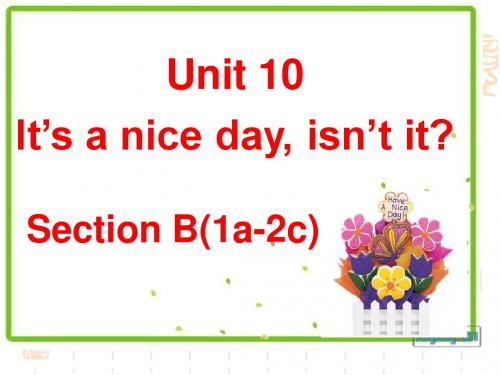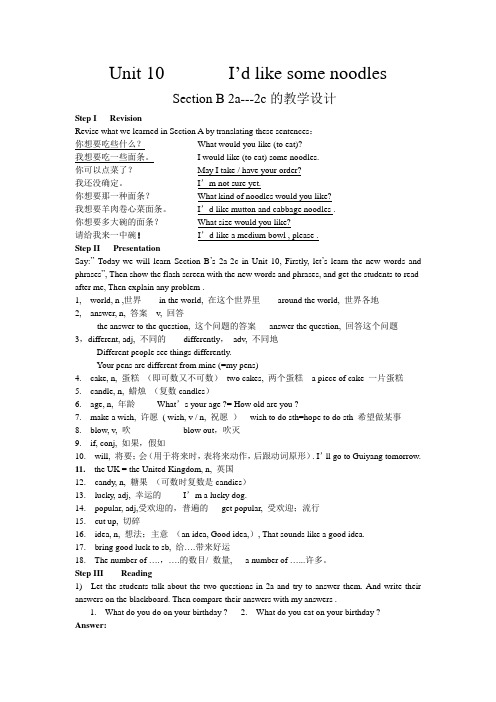人教版初一英语下Unit10 Section B 1a—2c教案
- 格式:doc
- 大小:50.00 KB
- 文档页数:6





Unit 10 I’d like some noodlesSection B 2a---2c的教学设计Step I RevisionRevise what we learned in Section A by translating these sentences:你想要吃些什么?What would you like (to eat)?我想要吃一些面条。
I would like (to eat) some noodles.你可以点菜了?May I take / have your order?我还没确定。
I’m not sure yet.你想要那一种面条?What kind of noodles would you like?我想要羊肉卷心菜面条。
I’d like mutton and cabbage noodles .你想要多大碗的面条?What size would you like?请给我来一中碗!I’d like a medium bowl , please .Step II PresentationSay:”Today we will learn Section B’s 2a-2c in Unit 10, Firstly, let’s learn the new words and phrases”, Then show the flash screen with the new words and phrases, and get the students to read after me, Then explain any problem .1, world, n ,世界in the world, 在这个世界里around the world, 世界各地2, answer, n, 答案v, 回答the answer to the question, 这个问题的答案answer the question, 回答这个问题3,different, adj, 不同的differently,adv, 不同地Different people see things differently.Your pens are different from mine (=my pens)4. cake, n, 蛋糕(即可数又不可数)two cakes, 两个蛋糕 a piece of cake 一片蛋糕5. candle, n, 蜡烛(复数candles)6. age, n, 年龄What’s your age ?= How old are you ?7. make a wish, 许愿( wish, v / n, 祝愿)wish to do sth=hope to do sth 希望做某事8. blow, v, 吹blow out,吹灭9. if, conj, 如果,假如10. will, 将要;会(用于将来时,表将来动作,后跟动词原形). I’ll go to Guiyang tomorrow.11. the UK = the United Kingdom, n, 英国12. candy, n, 糖果(可数时复数是candies)13. lucky, adj, 幸运的I’m a lucky dog.14. popular, adj,受欢迎的,普遍的get popular, 受欢迎;流行15. cut up, 切碎16. idea, n, 想法;主意(an idea, Good idea,), That sounds like a good idea.17. bring good luck to sb, 给….带来好运18. The number of ….,….的数目/ 数量, a number of …...许多。

Unit10 I’d like some noodles.Section B (2a-2c)I. Teaching goals:nguage goals:a.Get students to master the following new words:cake with candles, make a wish, blow out, get popular, cut up, symbol of long life …b. Get students to master the important sentences:①The answer would be different in differentcountries.② The number of candles is the person's age.③ In China, it's getting popular.2.Emotion goal:Get students to know birthday is a special day for everyone. And enjoy reading, we’ll find the world is wonderful.II. Teaching important and difficult points:a. Get students to master the new words and importantsentences.b. Improve students’ reading skills.III. Teaching processes:Step1. Lead inListen a birthday song and talk about “What do you do or eat on your birthday?”Step2. PresentationPresent some new words and expressions to the Ss. Students learn the new words and expressions by themselves and try to remember them.Step3.Reading1. Fast readingGuess ;Match the main idea of each paragraph .2. Careful readingRead the passage and complete the chart below.3. Read the messages again. Find the answers to the questions in 2c.Step4. After reading1.Read the passage again and complete the passage.2.Talent show.Step5. Outside readingWatch a video and know the different birthday foods in different countries.IV. HomeworkBlackboard design:教学反思:在进行本堂课之前,我已经做了充分的准备工作。
Unit 10 I’d like some noodles.Period 1 section A 1a-1cTeaching Aims and Demands1.Knowledge objects(1)Key words: noodles, beef, mutton, chicken, cabbage, potatoes, tomatoes.(2)Target Language: What kind of noodles would you like?I’d like beef and tomato noodles, please.(3)Listening practice and speaking practice(4)To learn the countable and uncountable nouns.2.Ability objectsTo train students’ ability of listening and speaking.Teaching Focuses1. To learn the names of food and the countable and uncountable nouns;2. To learn how to order food;3. To make pair work.Teaching ProceduresStep 1 Presentation1. Teach the new words of food used in noodles.2. Look at the numbered list of ingredients. Read and repeat.Step2. PresentationPractice “would like”1.A: What would you like? B:I’d like.....2.A:What kind of meat would you like? B:I’d like.....3.A:What kind of drink would you like? B:I’d like.....4. Ask students to match each word with the foods in 1a.5.Show the sign ___Special 1, Special2, Special3 to understand their meanings.Step3. Grammar1.Present the countable and uncountable nouns.2.List many words, and let the students discuss in groups and tell us what kinds of nouns thesewords are.Step4. PresentationPresent the target language as following:A: What would you like?B:I’d like.....A: What kind of noodles would you like?B: I’d like beef and tomato noodles, please.Step5. Practice the drill1、Read the conversation above.2、Ask students to work in pairs. One person is the waiter, the other one is the customer. Thenlet them perform the conversation in front of the classroom.Step6. Listening1b1、Show three bowls of noodles in picture. Ask: What ingredients are in these noodles?2、Play the recording the first time .Students only listen.3、Play the recording a second time and correct the answers.Step7. PresentationMake a survey to your friends. Ask: What kind of noodles would you like? Fill in the form, then make a report.Step8. PresentationPresent the target language as following:A: What size bowl of noodles would you like?B: I’d like a large / medium / small bowl of noodles.Step9. Role playLet the students perform the conversation as following, imagining they are in a restaurant (Each student can be both the waiter and the customer):A: What kind of noodles would you like?B: I’d like beef and tomato noodles, please.A: What size bowl of noodles would you like?B: I’d like a large / medium / small bowl of noodles.Step10. Listening1、Listen and check the names of the foods they hear in 2a.2、Listen and fill in the blanks in 2b.Play the recording a second time.Step11.Pair work1. Ask and answer questions with your partner. Use the information in 2a.2. Show the conversations of 2a on the big screen to the Ss.3. Make a model for the Ss.T: What kind of noodles would you like?S1: I'd like beef noodles, please.…3. Ss work in pairs and practice the conversations.Step 12. Role-play1. Ask Ss to read the conversation in 2d and find the answer to this question:What would they like?(They would like one large bowl of beef soup, one gongbao chicken, and one mapo tofu with rice.)2. Check the answers with the Ss.3. Ss work with their partners and role-play the conversation.Step 13 . Language points1. May I take your order? 你可以点菜了吗?也可以说“Can I take (have) your order?”,“Are you ready to order?”这些都是服务员请客人点菜的礼貌用语。
Unit 10 I’d like some noodles.
Section B (1a-2c)
一.概述
本单元中心话题是“点食品”具体涉及面条、饺子、甜食的种类,碗、杯的大小语言技能和语言知识几乎围绕“点食品”这一中心话题设计的。
“Section B”培养学生自主与合作的意思,通过活动,培养他的能力。
1a 部分通过让学生把几张图片和对应的食品,饮料,汤连接起来增加词汇为2a 部分中学生在对话中听到所点的饺子和饮料作铺垫,很自然的能使学生完成P82 2b的部分的表格地址,电话号码及所点东西。
再根据1a部分的食品也用电话的形式完成2b的表格是十分容易,降低了难度。
二.教学目标和要求
根据《英语新课程标准》关于总目标的具体描述,结合七年级学生实际和教材内容我将教学目标分为语言知识,语言技能,学习策略,情感态度4个方面:
1.语言知识:
词汇(vocabulary)
能理解运用以下生词:juice、dumpling、porridge、tea、green tea、rice、soup、onion、fish
功能(Functions):
让学生能够学会询问别人同时要学会点食品和点菜以及表达自己的意愿。
如:
I like dumplings , fish and orange juice.
I don’t like onions, green tea or porridge.
--Why do you like…? / Why don’t you like …?
--Because it’s …
语法(Grammar):
⑴掌握少数名词和不可数名词。
⑵掌握既是少数名词又是不可数名词的词。
⑶能够使用:I like…, … and …./ I don’t like …, … or ….
--Why do you like…?/ Why don’t you like …?
--Because it’s …
2.语言技能:
听:能捕捉到特殊信息,抓住关键词等听懂关于食物种类的对话,并搞清楚谈话人各自喜欢的食物。
说:能熟练掌握与话题相关的常用词汇与表达:如:表达自己的意愿;各种各样的食物;表达自己喜欢或不喜欢的东西,并说明原因。
使学生能就话题较好地完成一些开放性的话题,以提高在真实语境中的英语交际能力。
读:获取关于食品,水果,蔬菜,肉类的信息。
写:能根据实际情况写出订单。
3.学习策略:
学生能在一定程度上形成自主,有效交际,思语思维的能力,在推理与判断中培养综合分析能力。
4.情感态度:
⑴.让学生了解面条,饺子等食品和蔬菜,水果;
⑵.培养学生表达自己与他人的意见;
⑶.让学生去了解自己的同学和家人;
(4).培养学生合作和共享的学习态度。
5.教学重、难点
重点:1.词汇;掌握可数名词与不可数名词用法。
2 .学会询问别人同时要学会点食品和点菜以及表达自己的意愿。
难点:听清别人的请求,并表达出来。
三.学习者分析
该部分是在学习完Section A之后进行的,掌握了点食品及提供服务的句型。
通过上节课的内容,深入学习其他食品及听订单,写出别人预定的食物名称,地址,电话等详情,通过反复操练达到目的。
该班学生基础好,学习兴趣高,对本节内容知识能很好的掌握。
四.教学设计策略与设计
任务型教学,PAIRWORK,GROUPWORK等,要求学生在每一个环节中完成相应任务。
五.教学资源与工具设计
教师:教学课件,录音机等多媒体。
学生:复习Section A知识,预习本节课内容。
六.教学过程
Task 1 Greeting:
Hello, everyone. How are you today?
I’m Bill Ho. I come from Chaohe School. Glad to see you .I’m very happy ,because I can study Unit 8 Section B with you . Are you happy?
Task 2 Review:
1.Point the left students: Do you like tomatoes?
You’re Tomato Group ,OK?
Then Point the right students: Do you like potatoes?
You’re Potato Group ,OK?
You can have a slogan , for example: Tomato , tomato ,go ,go ,go !
2.Review these sentences:
--Can I help you ? /What can I do for you ?
--What kind of noodles would you like ?
--I’d like …noodles ,please .
--What size bowl of noodles would you like?
--I’d like a small/medium/large bowl of noodles.
Task 3 P resentation
1.Lead in: Look at me, am I fat? Yes ,I like eat delicious food , and you? OK , let’s go on eating delicious food .follow me.
2. Do you like these things? Show the pictures .Teach these new words.
3. Match the words with the pictures. Write the letter of the food on the blank line before its name.
4. PAIRWORK: Look at these words ,which are countable nouns ?which are uncountable nouns ?and which are countable nouns and uncountable nouns
Task 4 1b
1.Circle the things you like in the picture. And make an “×” next to the things you don’t like.
2. GROUP WORK .Let them practice , give leading.
I like dumplings ,fish and orange juice.
I don’t like onions, green tea or porridge.
--Why do you like…?/ Why don’t you like …?
--Because it’s …
3.Choose several students ask and answer. Encourage them.
Task 5 2a
1.Do you want get the delicious food in 1a? OK ,let’s listen
2.Play the recorder , let them listen carefully and circle in activity 1a the words that you hear on the tape.
3.You can get lots of food ,you’re clever . Check the answer.
Task 6 2b
1.If you are a waiter in a restaurant ,can you serve the customer?
2.Play the same recording again. Write down the customer’s address, telephone number and what he orders.
3.Check the answer ,which group is better?
Task 7 2c
1.Ok,now,let’s act it out. Can you?
2.GROUP WORK: Put students into pairs. Ask questions and fill in the order form..
Task 8 Summary
We have learnt lots of food.(Let them read )But we have to eat healthy food ,then we can keep healthy.
Task 9 Homework
Write an article about your favorite food.
教学过程流程图
七.教学评价设计
在复习中,检测学生对已学知识的掌握;从单词的认读中得知学生掌握单词的情况;在PAIRWORK,GROUPWORK过程中,学生通过对话进行自我评价、互评;在抽问学生中反馈情况,并予以适时鼓励。
八.帮助和总结
任务型教学中对学生每一环节的指导,如:句型的操练;单词抽认;“订
单”的详细情况;布置了介绍自己喜欢的食物的写作等。